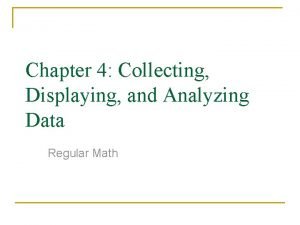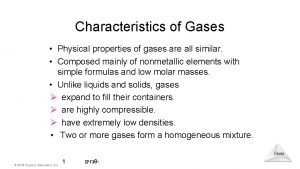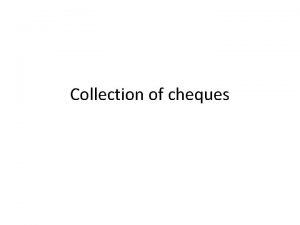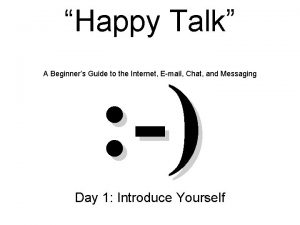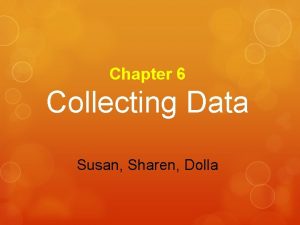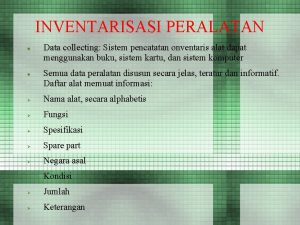A Guide to Collecting and Using Data Neil


































- Slides: 34

A Guide to Collecting and Using Data Neil H. Schwartz, Ph. D. 7/13/11 1

WHAT IS DATA AND WHY TAKE IT? Data is the measurement of key aspects of behavior. We measure these key aspects in order to understand the behavior. Data can tell us: Where behavior occurs. What situations trigger a behavior. If a behavior is part of a sequence that forms a behavioral chain. If a behavior is changing toward, or away from, the expected direction. Data is one of the strongest tools for making change. 7/13/11 2

WHAT ARE THE ASPECTS OF BEHAVIOR? Duration Frequency Intensity Aspects of Behavior Latency 7/13/11 3

WHAT IS FREQUENCY? The frequency of a behavior tells us how often a behavior occurs. How many times John bites others Hitting How many times John hits others. Pulling Hair How many times John pulls the hair of someone else. Biting To measure frequency, you simply count the number of times the behavior occurs. 7/13/11 4

WHAT IS DURATION? DURATION The duration of a behavior tells us how long a behavior lasts. Yelling When John howls, how long does it last? When John yells, how long does it last? Howling Eating When John eats, how long does it take him to finish his plate? To measure duration, you simply count the amount of time the behavior last when it occurs. 7/13/11 5

WHAT IS INTENSITY? INTENSITY The intensity of a behavior tells us how strong the behavior is. Yelling When John hits, how strong is it? When John yells, how loud is it? Hitting Exercising When John exercises, how much effort does he put into it? To measure intensity, you simply make a scale, and rate the behavior on the scale. 7/13/11 6

WHAT IS LATENCY? LATENCY The latency of a behavior tells us how long it takes for a behavior to begin after the antecedent is presented. When John is asked to turn off the TV, how long does it take him to comply? Cleaning up When John is asked to clean up, how long does it take him to begin? Getting up in the morning When John is awakened in the morning, how long does it take him to get out of bed? Turning off the TV To measure latency, you simply measure the time between the antecedent and the occurrence of the behavior. 7/13/11 7

HOW WOULD WE MEASURE FREQUENCY? FREQUENCY Frequency is the easiest aspect of behavior to measure. To measure, you simply designate whether the behavior was observed. There are several ways we try to make the measurement of behavioral frequency easy. We typically ask you to either: Circle symbols Monday Tuesday Wednesday Thursday Friday Saturday Sunday xxxxxx xxxxxx xxxxxx xxxxxx Wednesday Thursday Friday Saturday Sunday Make hash marks Monday ///// Tuesday /// // ////// 7/13/11 8

IF WE GRAPH THE FREQUENCY DATA WE COLLECTED… ay Su nd y ur da Sa t id ay Week 1 Fr Tu es da W y ed ne sd ay Th ur sd ay M on d ay It would look like this: 8 7 6 5 4 3 2 1 0 7/13/11 9

HOW WOULD WE MEASURE DURATION? DURATION Duration is a little trickier to measure than frequency. To measure duration, you could measure the time a behavior lasts. But, this would require you to use a stopwatch or keep your eye on a clock. The problem is: Stopwatches are no fun because they are a hassle to use. Watching a clock can be very distracting. So, there are several ways we try to make the measurement of behavioral duration easy. We can ask you to: Record start and stop time of the behavior by looking at a clock when the behavior starts and looking at the clock again when the behavior stops. Use momentary time sampling. Use interval sampling. We typically ask you to use: Clock start and stop time. Interval sampling. 7/13/11 10

WHAT IS INTERVAL SAMPLING? 7/13/11 11

Monday Tuesday 8: 00 -8: 10 Y N Y N Y 8: 10 -8: 20 Y N Y N 8: 20 -8: 40 Y N Y N Y 8: 40 -8: 50 Y N Y N 8: 50 -9: 00 Y N Y 9: 00 -9: 10 Y N 9: 10 -9: 20 Y N Y 9: 20 -9: 30 Y N 9: 30 -9: 40 Y 9: 40 -9: 50 -10: 00 Time Interval Wednesday Thursday Friday Saturday Sunday N Y N Y N Y N Y N Y N N Y N Y N Y N Y N Y N Y N Y N Y N Let’s say we measured “yelling” over a 2 -hour period in the morning. 7/13/11 12

WHAT DOES THIS RECORDING TELL US? 7/13/11 13

Monday Tuesday Saturday Sunday 8: 00 -8: 10 Y N Y N 8: 10 -8: 20 Y N Y N 8: 20 -8: 30 Y N Y N 8: 20 -8: 40 Y N Y N 8: 40 -8: 50 Y N Y N 8: 50 -9: 00 Y N Y N 9: 00 -9: 10 Y N Y N 9: 10 -9: 20 Y N Y N 9: 20 -9: 30 Y N Y N 9: 30 -9: 40 Y N Y N 9: 40 -9: 50 Y N Y N 9: 50 -10: 00 Y N Y N Time Interval Wednesday Thursday Friday 6/12 = 50% 5/12 = 42% 4/12 = 33% 3/12 = 25% 1/12 = 8% 60 min. in a 2 hr. period 50 min. in a 2 hr. period 40 min. in a 2 hr. period 30 min. in a 2 hr. period 10 min. in a 2 hr. period 7/13/11 14

IF WE GRAPH THE INTERVAL DURATION DATA WE COLLECTED… 70 60 50 40 30 20 10 0 ay Su nd y ur da Sa t ay id Fr da y ur s Th da y ed ne s da y W Tu es ay Week 1 on d M Amount of time yelling It would look like this: 7/13/11 15

IF WE GRAPH THE DURATION DATA WE COLLECTED IN ANOTHER WAY… It would look like this: ay Su nd y ur da Sa t ay id Fr da y ur s Th es da y W ed n y Week 1 Tu es da M on d ay Amount of time yelling 70 60 50 40 30 20 10 0 7/13/11 16

IF WE GRAPH THE DURATION DATA WE COLLECTED IN A THIRD WAY… It would look like this: 20% of yelling occurs on the weekend 40% of yelling occurs on Monday and Tuesday Monday Tuesday Wednesday Thursday Friday Saturday Sunday 7/13/11 17

HOW WOULD WE MEASURE INTENSITY? INTENSITY Intensity of behavior is easy to measure. All you need is a measuring scale. Once you have the scale, you simply observe the behavior and assign a value from the scale. We make up the scale for you, and ask you to assign a value from the scale as soon as the behavior is ended. Consider the scales on the next slide… 7/13/11 18

THESE ARE EXAMPLES OF INTENSITY SCALES One is a scale to measure mood: Extremely Sad -3 -2 -1 0 +1 +2 +3 Neutral Extremely Happy Another is a scale to measure the severity of tantrums: 1 Mild 2 3 Moderate 4 5 Severe 7/13/11 19

WHAT DO YOU DO TO MEASURE INTENSITY? Collecting data is very straightforward You simply: Observe the behavior Wait for it to end Assign a number from the scale Record the number in the empty cell Let’s look at the data collection example on the next slide… 7/13/11 20

-3 Extremely Sad -2 -1 0 +1 +2 +3 Neutral Extremely Happy Time of Day Monday Tuesday Wednesday Thursday Friday Saturday Sunday 8 -9 AM +1 0 -2 -1 +2 +3 +1 9 -10 AM +1 0 -2 -1 +2 +3 0 10 -11 AM +2 0 -2 0 +2 +3 0 11 -12 PM +2 0 -2 0 +1 +2 0 12 -1 PM +1 0 -1 0 +2 +2 +1 1 -2 PM 0 -1 -2 0 +1 +2 +1 2 -3 PM 0 -1 -2 0 +2 +1 +1 3 -4 PM -1 -2 -2 0 +1 +2 0 4 -5 PM -1 -2 -2 0 +1 +1 0 5 -6 PM -1 -3 -2 0 +1 +1 0 7/13/11 21

WHAT DO THE DATA TELL US? 7/13/11 22

Time of Day Monday Tuesday Wednesday Thursday Friday Saturday Sunday 8 -9 AM +1 0 -2 -1 +2 +3 +1 +1 0 -2 -1 +2 +3 0 10 -11 AM +2 0 -2 0 +2 +3 0 11 -12 PM +2 0 -2 0 +1 +2 0 12 -1 PM +1 0 -1 0 +2 +2 +1 1 -2 PM 0 -1 -2 0 +1 +2 +1 2 -3 PM 0 -1 -2 0 +2 +1 +1 3 -4 PM -1 -2 -2 0 +1 +2 0 4 -5 PM -1 -2 -2 0 +1 +1 0 5 -6 PM -1 -3 -2 0 +1 +1 0 . 4 -. 9 -1. 9 -. 2 1. 5 2. 0 . 4 9 -10 AM Mean . 4. 3. 5. 2. 1 -. 2 -. 3 -. 4 Let’s do a little math on the data. 7/13/11 23

WHAT CAN WE SEE WHEN THESE MOOD DATA ARE GRAPHED? 7/13/11 24

WHAT DOES OUR CLIENT’S MOOD LOOK LIKE OVER THE WEEK? Monday 2. 5 2 1. 5 1 0. 5 0 -0. 5 -1 -1. 5 -2 -2. 5 Tuesday Wednesday Thursday Friday Saturday Sunday Week 1 7/13/11 25

WHAT DOES OUR CLIENT’S MOOD LOOK LIKE DURING THE DAY? 0. 6 0. 5 0. 4 0. 3 0. 2 0. 1 During the Day 5 P M 4 P M 3 P M 2 P M 12 PM 11 AM -0. 2 10 AM 8 A M -0. 1 9 A M 0 -0. 3 -0. 4 -0. 5 7/13/11 26

WHY ARE GRAPHS SO IMPORTANT? Graphs tell a story; They give us the big picture. They reveal trends. They allow us to identify where interventions should be placed. They allow us to see improvements where we would otherwise see none. They can pinpoint difficult-to-notice antecedents. They can tell us when an intervention should be changed. 7/13/11 27

LET’S TAKE A LOOK AT SOME REAL GRAPHS These graphs are From real consumers at CVI. Based on real data. See what you learn about these consumers… 7/13/11 28

SOME REAL DATA… What do the data reveal. 7/13/11 29

WHAT DOES THIS TELL YOU? 7/13/11 30

WHAT DOES THIS TELL YOU? 7/13/11 31

AND THIS? WHAT DOES THIS SHOW? 300 250 200 EO 150 SIB AE 100 50 0 March April '10 May '10 June July '10 Aug '10 Sept Oct '10 Nov '10 Dec '10 Jan '11 Feb '11 March April '10 '11 May '11 7/13/11 32

2 -Jun 28 -May 26 -May 24 -May 20 -May 18 -May 13 -May 11 -May 7 -May 5 -May 3 -May 29 -Apr 27 -Apr 23 -Apr 21 -Apr 19 -Apr 15 -Apr 13 -Apr 8 -Apr 6 -Apr 1 -Apr 29 -May 25 -Mar 23 -Mar 19 -Mar 17 -Mar 15 -Mar 11 -Mar 9 -Mar 5 -Mar 3 -Mar 1 -Mar AND THIS? WHAT DOES THIS SHOW? 40 35 30 25 20 EO ABC 15 Linear(EO) Linear(ABC) 10 5 0 7/13/11 33

1 M ay Ap r 1 - ar M 1 - Fe b 1 - an 1 J ec D 1 - ov N 1 - ct O 1 - p Se 1 - g Au 1 - l Ju 1 - un 1 J 1 M ay Ap r 1 - ar M 1 - AND FINALLY: WHAT DOES THIS SHOW? 250 200 150 ACB 100 EO 50 0 7/13/11 34
 Collecting and displaying data
Collecting and displaying data Collecting highly parallel data for paraphrase evaluation
Collecting highly parallel data for paraphrase evaluation Samples of collecting engineering data
Samples of collecting engineering data Chapter 34 collecting and testing specimens
Chapter 34 collecting and testing specimens Collecting information and forecasting demand
Collecting information and forecasting demand Collecting information and forecasting demand summary
Collecting information and forecasting demand summary Neil data
Neil data Principal cells vs intercalated cells
Principal cells vs intercalated cells Interstitium
Interstitium Internal nares
Internal nares Mathsbot starter generator
Mathsbot starter generator Coupon collecting problem
Coupon collecting problem Collecting gas over water
Collecting gas over water Lumbar trunk
Lumbar trunk Collecting gas over water
Collecting gas over water Physics or stamp collecting
Physics or stamp collecting Coin collecting workshop
Coin collecting workshop Collect gas over water
Collect gas over water Dr frost collecting like terms
Dr frost collecting like terms Prize collecting steiner tree
Prize collecting steiner tree Collecting banker
Collecting banker Peter and jenny want to be alone question tag
Peter and jenny want to be alone question tag Visceral layer
Visceral layer Collecting ducts
Collecting ducts Collecting duct meaning
Collecting duct meaning Where does most reabsorption occur
Where does most reabsorption occur Collecting ducts
Collecting ducts Peritubular capillaries vs vasa recta
Peritubular capillaries vs vasa recta Collecting duct
Collecting duct Collecting duct meaning
Collecting duct meaning Michael collins buzz aldrin and neil armstrong
Michael collins buzz aldrin and neil armstrong Guide words
Guide words Beginners guide to using the internet
Beginners guide to using the internet System.collections.generics
System.collections.generics Accumulator ac
Accumulator ac
